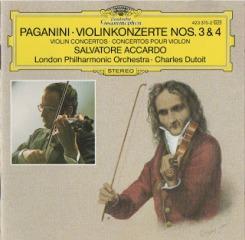Niccolo Paganini - Violin Concertos Nos.3 & 4 (Accardo) [1987]
Niccolo Paganini - Violin Concertos Nos.3 & 4 (Accardo) [1987]

Violin Concerto No.3 in E 1.1. Introduzione (Andante) - Allegro marziale - cadenza: Salvatore Accardo 18:08 2.2. Adagio (Cantabile spianato) 7:07 3.3. Polacca (Andantino vivace) 11:33 Violin Concerto No.4 in D minor 4.1. Allegro maestoso - cadenza: Salvatore Accardo 17:07 5.2. Adagio flebile con sentiment 6:50 6.3. Rondo galante (Andantino gaio) 11:06 Salvatore Accardo – violin London Philharmonic Orchestra Charles Dutoit – conductor
Composed in Naples in 1826, Niccolò Paganini's Concerto No. 3 in E major for violin and orchestra (MS 50) is not one of the man's more frequently played concertos; No. 1 is, of course, the best known, and No. 2 and No. 4 are more or less tied for second place. But there are many people, including such luminary violinists as Henryk Szeryng, who felt and feel that No. 3 is the most impressive of the set, both from a composition point of view and, as always with Paganini's violin music, from a technical show-off point of view. It is also usually the longest of the set, lasting better than half an hour in performance.
Only a few of Paganini's concertos survive intact. He was a tight-fisted man when it came to distributing copies of his pieces, and eagerly snatched the orchestral parts back up as soon as a performance of one of his concertos was finished. Thus, the orchestral parts and scores for several of the concertos are missing, and must be reconstructed if a performance is wished. Not so with the Concerto No. 3, whose autographed manuscript solo parts and orchestral score are intact and carefully preserved in a Roman library.
The concerto is in the usual three-movement format, and, as always in Paganini's concertos, Classical concerto form and turn-of-the century Italian opera style meet head-on. The first movement, "Introduzione" (Andante - Allegro marziale), begins playfully, with a series of pizzicato chirps from the orchestral strings; the winds and percussion, however, beg to differ, and, after a brief exuberant outburst, a stately, wholly operatic tune (complete with rhythmic blasts from the cymbal) is presented. Silken melody and jaw-dropping pyrotechnics take turns after the violinist enters. And, just as happens in the famous Concerto No. 1, there are episodes dedicated entirely to the playing of difficult parallel thirds.
The second movement is an Adagio that Paganini describes as Cantabile spianato, while the finale is a happy Polacca (in the polonaise's standard triple meter) that, at better than ten minutes, is quite a bit more bulky than most of Paganini's finales. Paganini gave the world premiere of this concerto in Vienna on July 24, 1828. --- Blair Johnston, Rovi
Niccolò Paganini composed his Violin Concerto No. 4 in D minor between the autumn of 1829 and the winter of 1830. He had already made his triumphant Viennese debut in 1828 using his astoundingly difficult first three Violin Concertos to demonstrate his unequaled virtuosity. But feeling a need for new repertoire while touring Germany, Paganini wrote his Fourth between performances, and although he wrote to his publisher that he intended to "deflower" the work in Paris, he actually performed it several times in Germany. In his review of the work, Ludwig Spohr wrote "in his composition and his style there is a strange mixture of consummate genius, childishness, and lack of taste that alternately charms and repels." Writing of the Parisian premiere, critic Castil-Blaze said that the work had a "most original form" and had "several highly picturesque effects." Cast in the standard three-movement form, Paganini's Concerto No. 4 opens with a stormy Allegro maestoso in D minor followed by a highly emotional Adagio flebile con sentimento in F sharp minor and closes with a racing Rondo galante in D minor with a novel obbligato triangle that no doubt elicited Castil-Blaze's comment on "picturesque effects." ---James Leonard, Rovi
download: uploaded yandex 4shared mediafire solidfiles mega filecloudio nornar ziddu
Zmieniony (Piątek, 07 Marzec 2014 14:05)








